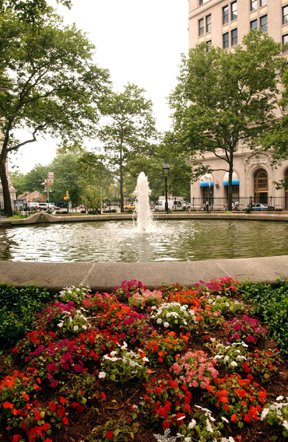Bowling Green
The Daily Plant : Wednesday, June 16, 2004
NEW YORK CITY’S OLDEST PARK GETS A MAKEOVER

New York City’s oldest park just became its newest-looking. With bright petunias and 70-year-old London plane trees blowing in the wind, Parks & Recreation Commissioner Adrian Benepe, Lower Manhattan Development Corporation President Kevin M. Rampe, and Community Board 1 Vice-Chair Richard Kennedy officially announced the renovation of Bowling Green Park with a ribbon cutting ceremony on Monday, June 14. The park received an $854,000 makeover courtesy of the Lower Manhattan Development Corporation.
"New York City’s first park has been given a new look, and this is just one of the over a dozen new and revitalized parks and green spaces downtown, with six to debut in the upcoming weeks," said Rampe.
"Our City’s planners broke the mold after they made Bowling Green Park—they literally stopped building parks downtown," said Benepe. "We’re working with the Lower Manhattan Development Corporation and a huge variety of public and private partners to bring green downtown."
The revival of the park is the second of 13 green spaces in Lower Manhattan scheduled to get a facelift, said Benepe. The Lower Manhattan Development Corporation awarded downtown parks more than $37 million after the events of September 11. "We’ve recreated lower Manhattan, and we’re in a better place than we’ve ever been," said Richard Kennedy.
Allan Scholl was the Project Designer and Charles Tesler was the Project Manager/Resident Engineer for the renovation, which included the reconstruction of the perimeter bluestone sidewalks and the interior paths within the park. New landscaping and plantings and the re-sodding of the lawn within the oval were among some of the beautification improvements made to give the park a modern vernacular, said Benepe.
Antique-style gas lamps and hoof benches were also placed in the park, with the addition of a new irrigation system for the park’s fountain. The historic iron fence encompassing the green was perhaps most in need of renovation. The fence was constructed in 1771 and later torn down after irate citizens hacked up a statue of King George III and ornaments on the surrounding fence to use as ammunition against the British. After the revolution, the fence was rebuilt and lamps were added.
The historic park dates back to 1626, when Dutch Governor Peter Miniut bought Manhattan Island for a mere $26 worth of merchandise. The green had been the final post of the Indian Trail and was used as a Lenape Indian Council Ground. The park was later used for herds of cattle and city parades until the City Council established it as an official park on March 12, 1733. The park’s fountain and central lawn area were removed in 1938 for New York City’s hosting of the World Fair. The fountain and pathway were returned in 1976, when the subway exit was relocated between the park and the U.S Customs House. Today, the green maintains its cultural heritage as it lies in front of the Smithsonian National Museum of the American Indian.
Bowling Green remains a lunchtime haven for employees and a historical site for visitors and residents alike. For this old park, looks really do improve with age.
Written by Melissa Kuhn
QUOTATION FOR THE DAY
" ‘Bosh!’ Stephen said rudely. ‘A man of genius makes no mistakes. His errors are volitional and are the portals to discovery.’"
James Joyce
Ulysses
Check out your park's Vital Signs
Clean & Safe
Green & Resilient
Empowered & Engaged Users
Share your feedback or learn more about how this park is part of a
Vital Park System










